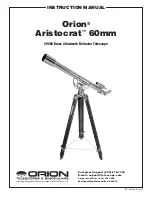
3
table of contents
1. Parts List. . . . . . . . . . . . . . . . . . . . . . . . . 3
2. Assembly . . . . . . . . . . . . . . . . . . . . . . . . 3
3. Getting Started . . . . . . . . . . . . . . . . . . . . 4
4. Setting up and Using the
Equaltorial mount . . . . . . . . . . . . . . . . . . 5
5. Astronomical Observing . . . . . . . . . . . . . 8
6. Terrestrial Viewing. . . . . . . . . . . . . . . . . 10
7. Transporting the Telescope. . . . . . . . . . 10
8. Care and Maintenance . . . . . . . . . . . . . 11
9. Specifications . . . . . . . . . . . . . . . . . . . . 11
1. Parts list
1
German equatorial mount
2
Slow-motion control cables
1
Counterweight shaft
1
Counterweight
3
Tripod legs
1
Optical tube assembly
2
Optical tube attachment knobs with washers
1
17mm Explorer II eyepiece
1
6mm Explorer II eyepiece
1
Mirror star diagonal
1
EZ Finder II reflex sight
1
Dust cover
1
Soft carry case
2. assembly
Carefully remove all of the items from the shipping box. Make
sure all the parts listed in the parts list are present. Save all boxes
and packaging material. In the unlikely event that you need to
return the telescope, you should use the original packaging.
Assembling the telescope for the first time should take about 10
minutes. No tools are required. During assembly (and anytime for
that matter), do not touch the any of the lenses of either the tele-
scope or the eyepieces with your fingers. The optical surfaces
have delicate coatings on them that can easily be damaged if
touched. Never remove any lens assembly from its housing for
any reason, or the product warranty and return policy will be voided.
Refer to Figure 1 during the assembly process.
1. Attach the tripod legs, one at a time, by threading them into
the holes at the base of the equatorial mount.
2. With the tripod legs now attached to the equatorial mount,
stand the mount upright.
3. Orient the equatorial mount as it appears in Figure 1, at a
latitude of about 40°, i.e., so the pointer next to the latitude
scale is pointing to the mark at “40.” To do this, loosen the
latitude lock T-bolt, and turn the latitude adjustment T-bolt until
the pointer and the “40” line up. Then retighten the latitude
lock T-bolt. The declination (Dec.) and right ascension (R.A.)
axes may also need re-positioning (rotation) to match Figure
1. Be sure to loosen the R.A. and Dec. lock knobs before
doing this. Retighten the R.A. and Dec. lock knobs once the
equatorial mount is properly oriented.
4. Thread the counterweight shaft into the equatorial mount at
the base of the declination axis until tight.
5. Remove the screw and washer on the bottom of the counter-
weight shaft and slide the counterweight onto the shaft. Make
sure the counterweight lock knob is adequately loosened to
allow the counterweight shaft to pass through the hole in the
counterweight. Position the counterweight about halfway up
the shaft and tighten the lock knob. Replace the screw and
washer on the end of the shaft.
6. Attach the two slow-motion control cables to the R.A. and
Dec. slow motion control shafts of the equatorial mount by
positioning the thumb screw on the end of the cable (you can
attach a control cable to either end of the R.A. slow-motion
C
ongratulations on your purchase of an Orion telescope. Your new Transporter 70 Min-EQ is the most
portable equatorially mounted telescope ever developed by Orion. Since it fits completely in its included
carrying case, you can take the Transporter 70 Min-EQ on camping trips, vacations, and anywhere else
you want to bring it. Weighing in at just over 12.5 lbs., the Transporter is a breeze to carry.
If you have never owned a telescope before, we would like to welcome you to amateur astronomy. Take
some time to familiarize yourself with the night sky. Learn to recognize the patterns of stars in the major
constellations. With a little practice, a little patience, and a reasonably dark sky away from city lights,
you’ll find your telescope to be a never-ending source of wonder and exploration.
These instructions will help you set up, properly use and care for your telescope. Please read over them
thoroughly before getting started.
Warning:
Never look directly at the Sun
through your telescope or its finder scope—
even for an instant—without a professionally
made solar filter that completely covers the front
of the instrument, or permanent eye damage
could result. Young children should use this
telescope only with adult supervision.






























